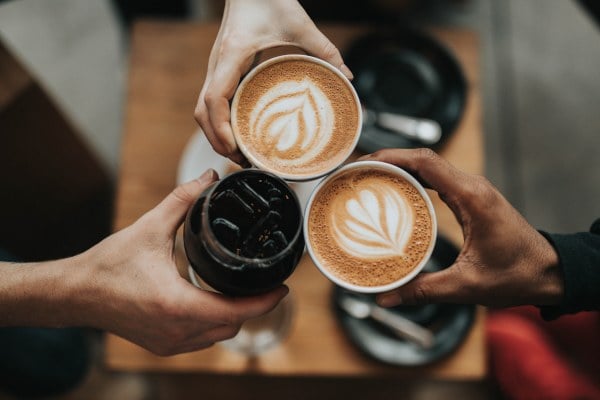Market Size For Coffee Shops: Analysis of Cafe Businesses
Despite the number of cafes and coffee shop businesses decreasing globally, the market size for coffee shops has been growing steadily for the last 10 years. Why does this happen? To explain these trends, we have to look at the global industry from the ground up. Then, at the smaller sections, or segments, within the coffee shop sector.
In this blog, we look at the value of the coffee market by country, by coffee shop type, and by consumer demand. We also look at the costs and profits of opening your own coffee shop.
How much is the global coffee trade worth?
To put the coffee market share into perspective, it's important to know that coffee is the highest traded commodity after oil across the world. Coffee is also the most exported agricultural commodity globally.
The 2022 market size for coffee is predicted to be around $205.8 billion USD ($295bn AUD), growing steadily at 3.5% for the next 5 years. By 2027, the market is forecasted to reach $244.40 billion USD ($350,3bn AUD) [1].
What is the coffee shop market size worldwide?
Here's a breakdown of the coffee market size across the globe:
- The Canadian coffee and snack shops market value is around $5 billion USD. ($6.4 bn CAD)
- The Australian market value is $10.5bn USD. (15.0bn AUD)
- In New Zealand, it's at $6.0bn USD. ($9.2bn NZD)
- The UK coffee market value is $5.4bn USD. (£4.0bn)
- In Ireland, the coffee shop market is worth $1.2bn USD. (1bn Euro)
- The United States have the largest coffee retail market size, worth $47.4bn as of 2022 [2].
While it's important to recognise the size and value of the market in each country, coffee shop owners can learn more about their industry when we look at a more detailed breakdown of market segments and their value.
What is the most popular type of coffee shop?
Lower priced coffee has the largest consumer base. This includes large coffee chains like Starbucks and Tim Hortons. Affordable coffee has became more popular and available due to the dominance large coffee chains embracing a 'fast-food' style model to produce instant, less expensive coffee.
This includes offering coffee via a drive-though, online ordering for quick pickup, and creating an assembly line format of baristas in each store. At the same time, these companies are also expanding their food menus to offer breakfast, lunch, appetizers and desserts, which typically offer a higher profit margin than coffee alone. Because of this, customers can buy coffee for around $1-$4.
How popular is artisanal coffee?
 The artisan and specialty coffee shops segment have experienced significant growth over the past decade. A surge in demand for ethically sourced coffee beans promoted the success of speciality coffee. Ryan de Oliveria, the co-founder of The Attendant, a coffee shop in London, says there is "a large demand" for ethical sourcing that goes beyond just buying traditional labels such as Fairtrade [3].
The artisan and specialty coffee shops segment have experienced significant growth over the past decade. A surge in demand for ethically sourced coffee beans promoted the success of speciality coffee. Ryan de Oliveria, the co-founder of The Attendant, a coffee shop in London, says there is "a large demand" for ethical sourcing that goes beyond just buying traditional labels such as Fairtrade [3].
Sustainably sourced coffee means farmers can be up to three-and-a-half times better off simply by selling their beans in the right way. The Attendant source their coffee from small farming communities in Uganda.
"People want to know that they are doing good and they don't want to buy something from a supply chain that is corrupt," says Mr de Oliveria. "For example, there was a lot of warfare in Uganda and we talk them through the impact we are trying to make with those farmers to stabilise their communities".
Coffee market segmentation by location
Location has a large part to play in the success of coffee shops. Large chain stores are very common in cities and metropolitan areas, as are independent cafes and coffee houses. In fact, certain coffee companies, such as Starbucks and Dunkin’ Donuts, set population density requirements before opening a new location. This tactic is being adopted by many of the key players in the coffee shops industry, including McCafe (McDonald's), CCD, and Nescafe [4].
How much does it cost to open a coffee shop?
A sit-down coffee shop can cost between $141k to $265k to open brand new due to the pricing of rent and commercial-grade equipment. Portable coffee vans typically cost around $20k. Coffee doesn’t require a large kitchen or storage space since most of the ingredients for the drinks are the same, as is the equipment used to make them.
Turning to the product itself, coffee is a relatively low-cost item. You have to sell a lot of it to generate a substantial income. However, the profit margins are incredibly high, typically 90% or upwards.
- A wholesale bag of arabica beans generally costs around $15-$23 per kilo. There are roughly 120-140 servings per kilo bag, therefore one cup will cost around 10p. Add milk for around 10c.
- The average cup of coffee costs around $2.45.
- Profits sit at $2.29 per cup, 93.5% gross profit (not including the takeaway cup, VAT or other prime costs).
This of course depends on the type of coffee beans being sold. As mentioned, Fairtrade and ethically sourced coffee have a higher cost price for coffee shop owners. Again, consumers are willing to pay more for a sustainably sourced brew.
Finding a sustainable coffee supplier
Coffee shop owners should consider the following factors when choosing a supplier:
- Quality: cost and high quality often go hand in hand. Loyal coffee drinkers will not return if they think your coffee is subpar.
- Reputation: ethical sourcing is a key concern for many people - again, this will reflect in the price you pay for your coffee products.
- Delivery: How frequently will your suppliers deliver your beans? You never want to run out of stock on a busy day!
Your coffee shop + Epos Now = The perfect blend
Epos Now offers state-of-the-art POS for hospitality businesses. We let you choose the tools and insights to help your business achieve its goals. Designed to work as a complete Cafe POS management system, you can control all vital aspects of your company from one cloud-based system.
Receive detailed analysis on the areas that matter to your business:
- Review profitability reports based on individual product performance, trending items, best and worst sellers, and employee sales
- View sales analyses on profit margin, cash flow, and other expenses
- Review reports on peak times for better staff scheduling and floorplan management
- Access multi-award-winning inventory management systems that sync online sales and in-person sales for the most up-to-date stock levels
- Automate stock purchasing so you never miss a sales opportunity
- Integrate with the business automation apps that are right for your business
- Table management and booking system integrations available for an optimised service
If you’d like to learn more about our industry-leading software, request a free callback with one of our experts.




